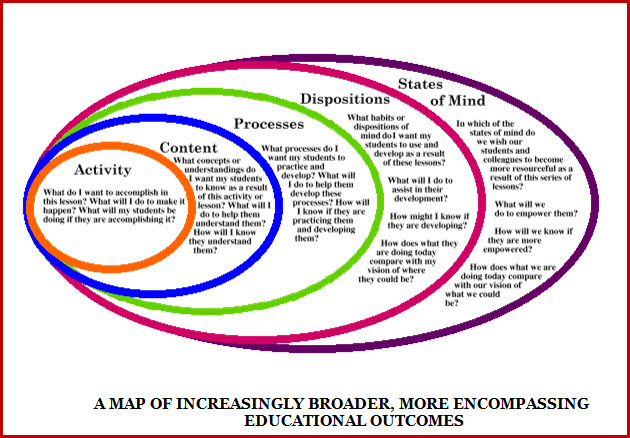Hello! We are Sheila Robinson Kohn from Greece Central School District and University of Rochester in NY, and Chad Green, from Loudoun County Public Schools in northern VA. We’re program co-chairs for the PreK-12 Educational Evaluation TIG and we welcome you to our sponsored AEA365 week, in honor of Teacher Appreciation Week.
We’d like to introduce you to our TIG’s mission, vision, and values in abbreviated form, and invite you to visit our website for the complete version, along with additional information about our TIG.
Mission: Raise the quality of educational evaluation.
Vision: Foster a close community of educational evaluators, become more responsive to context in education, and maintain high standards for educational evaluation practice.
Values: Relevant, responsive, high quality educational evaluation that reflects our beliefs in social justice, equity, and educating the whole child.
We invite you to explore Cognitive Coaching, developed by Costa and Garmston, a method focused on metacognition, or being aware of your own thinking processes. We both work extensively with coaching and mentoring programs and have found these roles useful in evaluation.
Lessons learned:
- It is important for evaluators to clearly understand the definitions of coaching, work to ensure stakeholders have a shared understanding of coaching roles, and specifically promote the fact that the role of the coach is not evaluative.
- There are at least five developmental stages of cognitive growth, or “nested levels of outcomes” for teachers according to Costa and Garmston’s framework, “each one broader and more encompassing than the level within and each representing greater authenticity.” (See figure below.)
- National education policy mandates that evaluators focus instrumentation on only two of the five stages of growth. This narrowing of perspectives limits cognitive capacity and complexity needed for more authentic educational outcomes (e.g., 21st century learning).
- Holistically, this approach represents a singular theory of change in education policy (management by objectives) that needs to be differentiated.
Hot Tip: Evaluators can refine their own practice by (a) scaffolding their thinking using Costa and Garmston’s map, (b) learning techniques from cognitive coaching, and (c) expanding their own theory(ies) of change to empower stakeholders (e.g., see Snowden, 2005).
(Source: Johns Hopkins University School of Education)
Rad Resource #1: Learn more about Costa and Garmston’s (1998) maturing outcomes map.
Rad Resource #2: Check out Snowden’s (2005) matrix representing four theories of change evaluators can use to scaffold their learning.
Key Question: “How can educational communities, constrained and limited by existing mindsets, curriculum and mandated assessments, mature in their capacity to think about more potent, multiple, simultaneous and complex outcomes?” (Costa & Garmston, 1998).
The American Evaluation Association is Educational Evaluation Week with our colleagues in the PreK-12 Educational Evaluation AEA Topical Interest Group. The contributions all this week to aea365 come from our EdEval TIG members. Do you have questions, concerns, kudos, or content to extend this aea365 contribution? Please add them in the comments section for this post on the aea365 webpage so that we may enrich our community of practice. Would you like to submit an aea365 Tip? Please send a note of interest to aea365@eval.org. aea365 is sponsored by the American Evaluation Association and provides a Tip-a-Day by and for evaluators.

Pingback: Ode to AEA365: A “Meta-post” | Sheila B Robinson
Pingback: EdEval Week: Krista Collins and Chad Green on Designing Evaluations with the Whole Child in Mind · AEA365
Salaam All,
Thanks for very informative post and innovative by means of the final part with Key Question in the Rad Resources section! You asked: How can educational communities, constrained and limited by existing mindsets, curriculum and mandated assessments, mature in their capacity to think about more potent, multiple, simultaneous and complex outcomes?”
I think key answer is: with new prorating values. If you look at your TIG values, the last value is "educating the whole child". Why? This value must be number 1 value in a practical manner in education systems, not only in a mission statement! You wrote: "We both work extensively with coaching and mentoring programs and have found these roles useful in evaluation." Nice find! I thing these educative roles are more important in total education systems. But when whole American formal education relies only on two above stages Activities & Content that less inclusive than other three: Processes, Dispositions & States of Mind, what Americans do?
If you accept this analysis and ask me why we have such relies in your education systems I answered this question in my today's post in Eval Talk.
Teachers must be really appreciated in all days not with words in some days! We must respect our teachers by our trust and with paying attention to right assumption and showing false assumptions in our education, economic & political systems!
When the whole education systems are on the fingers of test industry propaganda, what are the meanings of theories of change, individual differences & cognitive growth?
Best especially for my friend Chad and All
Moein